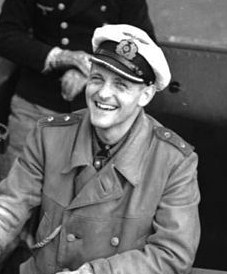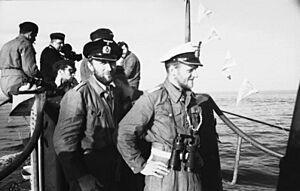Erich Topp facts for kids
Quick facts for kids
Erich Topp
|
|
|---|---|

Topp in 1942
|
|
| Born | 2 July 1914 Hannover, German Empire |
| Died | 26 December 2005 (aged 91) Süßen, Germany |
| Allegiance | |
| Service/ |
|
| Years of service | 1934–45 1958–69 |
| Rank | Kriegsmarine: Bundesmarine: |
| Service number | NSDAP #2,621,078 |
| Unit | 1st U-boat Flotilla 7th U-boat Flotilla 4th U-boat Flotilla 11th U-boat Flotilla |
| Commands held | U-57 U-552 U-3010 U-2513 |
| Battles/wars |
See battles
|
| Awards | Knight's Cross of the Iron Cross with Oak Leaves and Swords Great Cross of Merit |
Erich Topp (born July 2, 1914 – died December 26, 2005) was a German U-boat commander during World War II. He was known for sinking many ships. After the war, he joined the Federal German Navy and became a high-ranking officer called a Konteradmiral (rear admiral). He also worked with NATO.
Contents
Erich Topp was born in Hannover, Germany. He joined the German navy, then called the Reichsmarine, in April 1934. He started his training on a school ship called Gorch Fock. Later, he moved to a light cruiser, the Karlsruhe. On this ship, he sailed on a long training trip across the Atlantic Ocean. They visited places like the Azores and Trinidad.
After his journey, Topp studied at the Naval Academy Mürwik. He became an officer cadet in 1935. He continued his training on the Karlsruhe for some time. In April 1937, he became a Leutnant zur See (second lieutenant). He also took a special course about torpedoes.
In October 1937, Topp began his U-boat training. U-boats are submarines. He learned how to operate them at a special school. After his training, he became an officer on U-46. In April 1939, he was promoted to Oberleutnant zur See (sublieutenant).
Joining the Nazi Party
In 1933, Erich Topp joined the Nazi Party. He also joined the Allgemeine-SS in 1934. He took an oath to Adolf Hitler. Topp later said he didn't believe in Nazi ideas. His aunt, who was Jewish, survived the Theresienstadt Ghetto during the war. After the war, Topp spoke out against some former naval leaders. He believed they knew about the terrible crimes committed by the Nazis.
World War II Service
World War II started in September 1939. Topp was already at sea on U-46. He went on several patrols with this U-boat. During these missions, U-46 sank two ships. For his service, Topp received the U-boat War Badge and the Iron Cross 2nd Class. In May 1940, he moved to the 1st U-boat Flotilla.
Commanding U-57
In June 1940, Erich Topp became the commander of U-57. He took U-57 on its fifth war patrol into the North Atlantic. During this patrol, he sank three ships. In August 1940, U-57 left for another patrol. Topp sank three more ships and damaged one.
On September 3, 1940, U-57 had an accident. It crashed into a Norwegian ship called Rona and sank. Luckily, the U-boat was later lifted and used for training. After this, Topp received the Iron Cross 1st Class. He then went to a shipyard to learn about building a new type of U-boat, the Type VIIC.
Leading U-552
In December 1940, Topp took command of German submarine U-552. This was a new Type VIIC U-boat. After testing and training, U-552 began its first war patrol in February 1941. They sailed to the North Atlantic. Topp sank two ships on this mission.
His second patrol on U-552 started in April 1941. They went to the North Atlantic, south of Iceland. Topp sank three ships and damaged another. One of the ships sunk was the troopship S.S. Nerissa. Many lives were lost in this sinking.
In May, Topp went on his third patrol. He sank three more ships. For his success, he was awarded the Knight's Cross of the Iron Cross in June 1941. One of the ships he sank was the Norfolk, which carried mail and cargo.
Topp continued his patrols with U-552. On his fourth patrol, he sank one ship. In September 1941, he was promoted to Kapitänleutnant (lieutenant commander). On his fifth patrol, he sank three more ships in the North Atlantic.
Sinking the Reuben James
On October 25, 1941, Topp began his sixth patrol. During this mission, he sank the American destroyer USS Reuben James. This happened on October 31, 1941. The Reuben James was the first United States Navy warship lost in World War II. It was helping to protect a convoy of ships. The torpedo hit the front of the ship, causing a large explosion. Many sailors were lost. This event made the relationship between Germany and the United States even worse.
The "Second Happy Time"
On December 11, 1941, Germany declared war on the United States. German U-boats then began attacking ships off the East Coast of the United States. This period was called the "Second Happy Time" by the Germans. Many ships were sunk because American defenses were not yet ready for war. Topp joined this effort with U-552.
On his seventh patrol, Topp sank three ships. He had some problems with his torpedoes not working correctly. He reported these issues to his command.
His eighth patrol took U-552 to the East Coast of the United States. Topp sank seven ships on this mission. In April 1942, he received the Knight's Cross of the Iron Cross with Oak Leaves. He also received the U-boat War Badge with Diamonds.
One of the ships Topp sank was the SS David H. Atwater, a coastal steamer. This happened on April 3, 1942. Topp surfaced his U-boat and attacked the ship with his deck gun. Many of the civilian crew members lost their lives.
Topp's ninth patrol on U-552 was in the North Atlantic. He sank five ships that were part of a convoy. On his tenth and final patrol with U-552, Topp sank two more ships and damaged two others. When he returned, he was awarded the Knight's Cross of the Iron Cross with Oak Leaves and Swords in August 1942. He was also promoted to Korvettenkapitän (corvette captain).
Shore Duty and New U-boats
After his time commanding U-552, Topp was given a new role on shore. He became the chief of the 27th U-boat Flotilla. This was a training group for U-boat crews. In August 1944, Topp was put in charge of bringing new Type XXI submarines into service. These were advanced submarines designed to stay underwater for longer. In December 1944, he was promoted to Fregattenkapitän (frigate captain).
In March 1945, he briefly commanded U-3010 and then U-2513. In May 1945, Topp was captured as a prisoner of war in Norway. He was released in August 1945. His U-boat, U-2513, was later tested by the US Navy. They found it to be very quiet and fast underwater.
Life After the War

After the war, Erich Topp studied architecture at the Leibniz University Hannover. He became an engineer in 1950. He also worked as a technical advisor for a movie called Sharks and Little Fish.
In 1958, Topp joined West Germany's new navy, the Bundesmarine. He started as a Fregattenkapitän. He worked with the NATO Military Committee in Washington, D.C. He was promoted to Kapitän zur See (captain) in 1959.
Topp held several important positions in the Bundesmarine. He commanded the "amphibious forces" and later became the chief-of-staff of the Fleet Command. In 1965, he was promoted to Flottillenadmiral (flotilla admiral). In 1966, he became the deputy Inspector of the Navy and was promoted to Konteradmiral (counter admiral). He retired from the navy in December 1969. For his service, he received the Commander's Cross of the Order of Merit of the Federal Republic of Germany.
After retiring, Topp worked as a technical advisor for a German shipyard. He also helped with a computer game called Silent Hunter II. He was interviewed for a TV show about a lost German U-boat.
Erich Topp passed away on December 26, 2005, at the age of 91. He is remembered as a skilled U-boat commander and a respected officer in the post-war German navy.
Awards and Honors
- U-boat War Badge (November 7, 1939)
- with Diamonds (April 11, 1942)
- Honorary dagger of the Kriegsmarine with Diamonds (August 17, 1942)
- War Merit Cross
- 2nd Class with Swords (January 30, 1944)
- 1st Class with Swords (1944)
- Iron Cross (1939)
- 2nd Class (January 1, 1940)
- 1st Class (September 1, 1940)
- Knight's Cross of the Iron Cross with Oak Leaves and Swords
- Knight's Cross on June 20, 1941, as Oberleutnant zur See and commander of U-552
- 87th Oak Leaves on April 11, 1942, as Kapitänleutnant and commander of U-552
- 17th Swords on August 17, 1942, as Kapitänleutnant and commander of U-552
- Commander's Cross of the Order of Merit of the Federal Republic of Germany (September 19, 1969)


